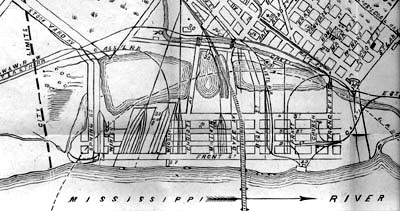 Railroad
Development around the American Bottom region
Railroad
Development around the American Bottom region Railroad
Development around the American Bottom region
Railroad
Development around the American Bottom regionDuring the 1850s the Atlantic and Mississippi Railroad and the Ohio and Mississippi Railroad placed lines in Illinoistown. The Atlantic and Mississippi Railroad also had lines in Alton. Some towns that these major lines bypassed, like Belleville, Illinois, secured branch lines to Illinoistown. Alton managed to secure a line to Springfield, Illinois, and that line allowed a connection to Chicago using the Illinois Central Railroad and the Chicago and Rock Island Railroad. However, geography, line placement, and a change in state policy ended Alton's bid to become a significant terminus. Illinoistown would grow into East St. Louis, the nation's largest rail terminus by 1900. The choice of East St. Louis had many considerations. The city was just across the river from St. Louis, the railroads already located lines to the area, and the state of Illinois abandoned its plans to restrict rail lines leading to out-of-state interests. Had Alton won this competition, its leaders believed it could rival St. Louis as the central metropolis along the midwestern part of the Mississippi.
 |
| This selection from a map shows the first of what would become many terminal rail lines in East St. Louis |
During the nineteenth century such fierce competition reflected the growth of an economic and geographic hierarchy among midwestern cities including Chicago, St. Louis, Cincinnati, and Louisville, and second order cities serving as collection and service stations such Alton, Belleville, and Illinoistown/East St. Louis. At the same time St. Louis secured Illinoistown as a service center, Chicago expanded at an even faster rate. The completion of the Illinois and Michigan canal in 1848 and the Illinois Central Railroad, which ran from Chicago to Cairo, Illinois, allowed the Windy City to divert trade from a north-south flow to an east-west direction, hurting St. Louis' trade. During the Civil War the American Bottom region lost more trade as the Union Army blockaded southern trade while Chicago's east-west trade continued. So while Chicago became the dominant city among the larger cities, East St. Louis helped keep St. Louis a vital city on the Mississippi.